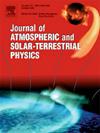一种利用简单气象资料估算地表折射率的新方法
IF 1.9
4区 地球科学
Q3 GEOCHEMISTRY & GEOPHYSICS
Journal of Atmospheric and Solar-Terrestrial Physics
Pub Date : 2025-04-10
DOI:10.1016/j.jastp.2025.106510
引用次数: 0
摘要
本文利用18年(2006-2023年)的气象资料,分析了美国德克萨斯州休斯顿亚热带气候区地表折射模式,并提出了6个地表折射模式估算的经验模型。月、年变化呈夏季高峰(7月372.4 N单位),冬季最低(12月327.8 N单位)。干湿成分的贡献分析表明,冬季干成分占主导地位(61 ~ 63%),夏季湿成分占主导地位(56 ~ 60%)。提出的模型使用空气温度、大气压力和相对湿度作为输入变量。采用统计指标和赤池信息准则(Akaike Information Criterion, AIC)对模型的性能进行评价。模型的残差与正态分布密切相关,表明预测能力稳健可靠,有助于提高对地表折射率的理解。模型3是一个包含气温和大气压力的双变量线性模型(Ni= - 33.7689+1.3234(T) - 0.0069(P)),具有最低的AIC(6.829)、AICC(12.543)和ΔAICC(0.000)值,与实测值的偏差在- 1.80% ~ 2.38%之间。模型1是一个简单的单变量线性模型,仅使用空气温度(Ni= - 41.2088+1.3250(T)),也表现出很强的性能,偏差范围为0.12%至6.36%。对比分析表明,当地开发的模型明显优于标准折射率方程,突出了特定位置经验模型对于准确估计表面折射率的重要性。重要的是,这些模型完全依赖于容易获得的空气温度和大气压力测量,消除了对太阳辐射数据的需要,使它们更容易在不同地区应用。这些发现对模拟类似气候区域的无线电波传播、雷达系统、电信规划和大气研究具有重要意义。本文章由计算机程序翻译,如有差异,请以英文原文为准。

A novel approach to estimate surface refractivity with simple meteorological data
This study analyzes surface refractivity patterns and proposes six empirical models for its estimation in Houston, Texas, a subtropical climate region of the United States, using 18 years (2006–2023) of meteorological data. Monthly and yearly variations revealed a seasonal pattern peaking in summer (372.4 N units in July) and reaching its lowest in winter (327.8 N units in December). An analysis of the contributions of the dry and wet components shows the dry component dominating in the winter (61–63 %) and the wet component prevailing in the summer (56–60 %). The proposed models were developed using air temperature, atmospheric pressure, and relative humidity as input variables. Models’ performances were evaluated using statistical metrics and the Akaike Information Criterion (AIC). The models' residuals closely followed a normal distribution, indicating robust and reliable predictive capabilities that enhance understanding of surface refractivity. Model 3, a two-variable linear model incorporating air temperature and atmospheric pressure (, was identified as the best performing model with the lowest AIC (6.829), AICC (12.543), and ΔAICC (0.000) values and deviations between −1.80 % and 2.38 % from the measured values. Model 1, a simpler single-variable linear model using only air temperature (), also showed strong performance, with deviations ranging from 0.12 % to 6.36 %. Comparative analysis indicated that locally developed models significantly outperformed the standard refractivity equation, highlighting the importance of location-specific empirical models for accurate surface refractivity estimation. Importantly, these models rely solely on readily accessible air temperature and atmospheric pressure measurements, eliminating the need for solar radiation data and enabling their easier application across diverse regions. These findings have implications for modeling radio wave propagation, radar systems, telecommunications planning, and atmospheric studies in similar climate regions.
求助全文
通过发布文献求助,成功后即可免费获取论文全文。
去求助
来源期刊

Journal of Atmospheric and Solar-Terrestrial Physics
地学-地球化学与地球物理
CiteScore
4.10
自引率
5.30%
发文量
95
审稿时长
6 months
期刊介绍:
The Journal of Atmospheric and Solar-Terrestrial Physics (JASTP) is an international journal concerned with the inter-disciplinary science of the Earth''s atmospheric and space environment, especially the highly varied and highly variable physical phenomena that occur in this natural laboratory and the processes that couple them.
The journal covers the physical processes operating in the troposphere, stratosphere, mesosphere, thermosphere, ionosphere, magnetosphere, the Sun, interplanetary medium, and heliosphere. Phenomena occurring in other "spheres", solar influences on climate, and supporting laboratory measurements are also considered. The journal deals especially with the coupling between the different regions.
Solar flares, coronal mass ejections, and other energetic events on the Sun create interesting and important perturbations in the near-Earth space environment. The physics of such "space weather" is central to the Journal of Atmospheric and Solar-Terrestrial Physics and the journal welcomes papers that lead in the direction of a predictive understanding of the coupled system. Regarding the upper atmosphere, the subjects of aeronomy, geomagnetism and geoelectricity, auroral phenomena, radio wave propagation, and plasma instabilities, are examples within the broad field of solar-terrestrial physics which emphasise the energy exchange between the solar wind, the magnetospheric and ionospheric plasmas, and the neutral gas. In the lower atmosphere, topics covered range from mesoscale to global scale dynamics, to atmospheric electricity, lightning and its effects, and to anthropogenic changes.
 求助内容:
求助内容: 应助结果提醒方式:
应助结果提醒方式:


